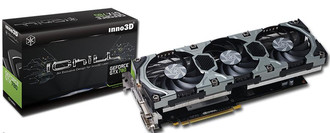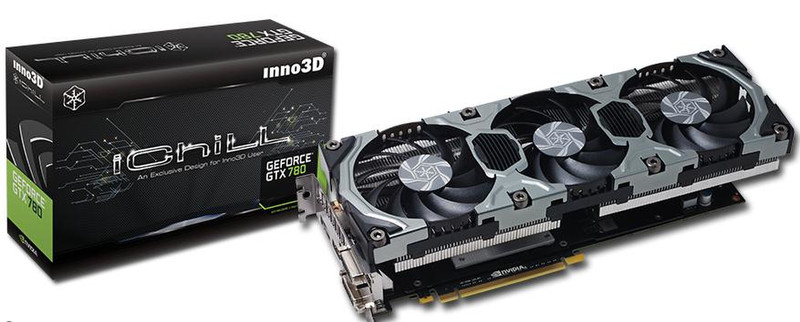Catalog
-
Catalog
- Antiquitäten & Kunst
- Auto & Motorrad: Fahrzeuge
- Baby
- Business & Industry
- Bücher
- Camping & Outdoor
- Feinschmecker
- Garden & patio
- Haustierbedarf
- Heimwerken & Garten
- HiFi & Audio
- Home, Construction, Renovation
- Household appliances
- Kleidung & Accessoires
- Modellbau
- Musik
- PC- & Videospiele
- Photo & camcorders
- Sammeln & Seltenes
- Spielzeug
- TV, Video, DVD
- Telekommunikation
- Uhren & Schmuck
- Wellness & Beauty
- computers & electronics
- entertainment & hobby
- fashion & lifestyle
- food, beverages & tobacco
- health & beauty
- institutional food services equipment
- medical equipment, accessories & supplies
- office
- sports & recreation
- vehicles & accessories
- weapons & ammunition
Filters
Search

Inno3D GeForce GTX 780 iChill HerculeZ X3 Ultra 3GB graphics card
🚚 Select the country of delivery:
Delivery from:
Germany
Sale and delivery by:
Where to buy and prices (Advertising *)
On Top
Technical specifications
On Top
Performance
| DirectX version | 11.1 |
|---|---|
| OpenGL version | 4.3 |
| NVIDIA GameWorks VR | N |
| Fill rate | 186 billion texels/sec |
| NVIDIA G-SYNC | Y |
| Shader model version | 5.0 |
| HDCP | Y |
| Full HD | Y |
| TV tuner integrated | N |
| PhysX | Y |
| NVIDIA 3D Vision | Y |
Memory
| Graphics adapter memory type | GDDR5 |
|---|---|
| Memory bus | 384 bit |
| Memory bandwidth (max) | 297.6 GB/s |
| Discrete graphics adapter memory | 3 GB |
Processor
| Graphics processor family | NVIDIA |
|---|---|
| Processor frequency | 1006 MHz |
| FireStream | N |
| Processor boost clock speed | 1046 MHz |
| CUDA | Y |
Ports & interfaces
| Interface type | PCI Express 3.0 |
|---|---|
| HDMI ports quantity | 1 |
| DisplayPorts quantity | 1 |
Design
| Cooling type | Active |
|---|
Power
| Minimum system power supply | 600 W |
|---|
Additionally
| Dual-link DVI | Y |
|---|---|
| Graphics controller | GeForce GTX 780 |
NVIDIA GeForce GTX 780 3GB GDDR5, 384-bit, PCI-E 3.0
The new GeForce GTX 780 marks an evolution in gaming performance—an insanely fast, smooth, and whisper-quiet experience, every time.
It features a massively powerful NVIDIA Kepler™ GPU of 2,304 cores—50% more than its predecessor. Plus, it comes with 3 GB of high-speed GDDR5 memory and NVIDIA GPU Boost 2.0 technology, giving you the performance capabilities you need to game at extreme settings.
The GTX 780 is more than just fast and smooth. It’s perfectly tuned to today’s most advanced gaming technologies with features like GeForce Experience™ for one-click driver and settings optimization, plus NVIDIA® PhysX® and TXAA™ for smooth, sharp graphics.
Experience pure performance. Game on.
NVIDIA PhysX technology helps games play better and feel better by making interaction with environments and characters far more realistic than ever before. By making behavior more realistic, the graphics look and “feel” better. In the beginnings of 3D Gaming, characters and worlds were basically built from boxes with decals on them. As technology has advanced, the boxes have become more geometrically detailed polygons, and the decals have become more accurately shaded and lit textures. However, most people still perceive an “uncanny divide” between a game environment and reality that prevents a proper suspension of belief and immersion into the world of the game. Before PhysX, game designers had to “precompute” how an object would behave in reaction to an event. For example, they would draw a sequence of frames showing how a football player falls on the ground after a tackle. The disadvantage of this approach was that the gamer always saw the same “canned” animation. With PhysX, games can now accurately compute the physical behavior of bodies real time! This means that the football player will now bend and twist in all different ways depending on the specific conditions associated with the tackle – thus creating a unique visual experience every time. PhysX technology is widely adopted by over 150 games and is used by more than 10,000 developers. With hardware-accelerated physics, the world’s leading game designers’ worlds come to life: walls can be realistically torn down, trees bend and break in the wind, and water and smoke flows and interacts with body and force, instead of just getting cut-off by neighboring objects.
PhysX is designed specifically for hardware acceleration by powerful processors with hundreds of processing cores. Because of this design choice, NVIDIA GeForce GPUs provide a dramatic increase in physics processing power, and take gaming to a new level delivering rich, immersive physical gaming environments with features such as:
- Explosions that create dust and collateral debris
- Characters with complex, jointed geometries, for more life-like motion and interaction
- Spectacular new weapons with incredible effects
- Cloth that drapes and tears naturally
- Dense smoke & fog that billow around objects in motion
It features a massively powerful NVIDIA Kepler™ GPU of 2,304 cores—50% more than its predecessor. Plus, it comes with 3 GB of high-speed GDDR5 memory and NVIDIA GPU Boost 2.0 technology, giving you the performance capabilities you need to game at extreme settings.
The GTX 780 is more than just fast and smooth. It’s perfectly tuned to today’s most advanced gaming technologies with features like GeForce Experience™ for one-click driver and settings optimization, plus NVIDIA® PhysX® and TXAA™ for smooth, sharp graphics.
Experience pure performance. Game on.
NVIDIA PhysX technology helps games play better and feel better by making interaction with environments and characters far more realistic than ever before. By making behavior more realistic, the graphics look and “feel” better. In the beginnings of 3D Gaming, characters and worlds were basically built from boxes with decals on them. As technology has advanced, the boxes have become more geometrically detailed polygons, and the decals have become more accurately shaded and lit textures. However, most people still perceive an “uncanny divide” between a game environment and reality that prevents a proper suspension of belief and immersion into the world of the game. Before PhysX, game designers had to “precompute” how an object would behave in reaction to an event. For example, they would draw a sequence of frames showing how a football player falls on the ground after a tackle. The disadvantage of this approach was that the gamer always saw the same “canned” animation. With PhysX, games can now accurately compute the physical behavior of bodies real time! This means that the football player will now bend and twist in all different ways depending on the specific conditions associated with the tackle – thus creating a unique visual experience every time. PhysX technology is widely adopted by over 150 games and is used by more than 10,000 developers. With hardware-accelerated physics, the world’s leading game designers’ worlds come to life: walls can be realistically torn down, trees bend and break in the wind, and water and smoke flows and interacts with body and force, instead of just getting cut-off by neighboring objects.
PhysX is designed specifically for hardware acceleration by powerful processors with hundreds of processing cores. Because of this design choice, NVIDIA GeForce GPUs provide a dramatic increase in physics processing power, and take gaming to a new level delivering rich, immersive physical gaming environments with features such as:
- Explosions that create dust and collateral debris
- Characters with complex, jointed geometries, for more life-like motion and interaction
- Spectacular new weapons with incredible effects
- Cloth that drapes and tears naturally
- Dense smoke & fog that billow around objects in motion
-
Payment Methods
We accept:












